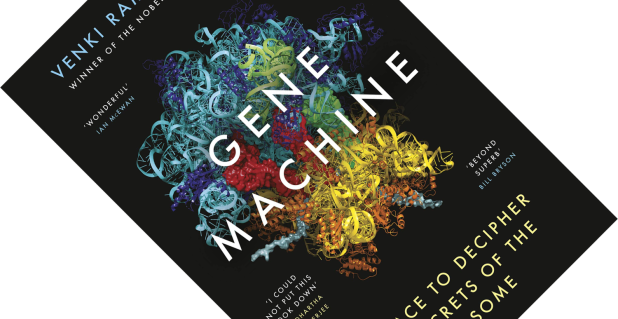DNA has lodged itself in the public imagination as the “blueprint” of life and as other, often slightly deceiving, metaphors. But what happens next? How do organisms actually get anything done with the information coded in DNA? For biologists, this is standard textbook fare: DNA is copied into single-stranded RNA which is then translated, three letters at a time, into amino acids that, when strung together, make up the workhorses of the cell: proteins. The cell organ, or organelle, that does the latter part is the ribosome, which Venki Ramakrishnan introduces here in Gene Machine. He has written a riveting first-hand account of the academic race to describe its structure, and how, in the process, he bagged a shared Nobel Prize in Chemistry in 2009.

“Gene Machine: The Race to Decipher the Secrets of the Ribosome“, written by Venki Ramakrishnan, published in Europe by Oneworld Publications in September 2018 (hardback, 272 pages)
Ramakrishnan initially intended to become a theoretical physicist, but soon became fascinated with biology. After finishing his PhD in physics he started over as a biology graduate. The bulk of this book describes how he became enamoured with learning more about the ribosome and spent decades studying it, going from student to postdoc to professorship, all the while recruiting brilliant students and colleagues to collaborate with. But he did not operate alone. As the decades progressed and more of the ribosome’s structure was clarified, competition for publication in top-tier journals intensified. Various research groups around the world were working in parallel towards the same goal: a complete, detailed structural description of all the protein and RNA elements making up a ribosome.
Ramakrishnan has purposefully decided to make this book foremost a personal memoir of his contributions during those decades of research, and of those of his collaborators and competitors. He describes the many pitfalls, mistakes, tensions, and rivalries with disarming honesty and gives a very good picture of what real science looks like “in the wild”.
“[Ramakrishnan] describes the many pitfalls, mistakes, tensions, and rivalries with disarming honesty.”
If you were hoping for an accessible overview of the current state of ribosome biology, this book might leave you wanting more. For example, Ramakrishnan almost off-handedly mentions how we have come to learn that “the” ribosome doesn’t exist, but there seem to be many types, something which he does not elaborate on. Another interesting observation is that the core of ribosomes consists entirely of RNA, with various clusters of proteins on the outside. Since many scientists think that life started off as single-stranded RNA acquiring the ability to self-replicate (see Life from an RNA World: The Ancestor within), this could point to how the ribosome evolved. By the time the structure of the ribosome was finally elucidated by x-ray crystallography, further technical developments in electron microscopy made it possible to use that technique instead, with superior results. This is very reminiscent of the rapid developments in DNA sequencing, where the first efforts were herculean and incredibly costly, after which new developments accelerated and eased the process tremendously.
I would have loved to know more about these and other details, especially as there is no good popular science book on ribosomes so far – instead DNA gets all the love (see for example The Gene: An Intimate History, She Has Her Mother’s Laugh: The Powers, Perversions, and Potential of Heredity, or Blueprint: How DNA Makes Us Who We Are). I am convinced that Ramakrishnan could have written a fantastically readable overview, as he does a good job of familiarising readers with his method of choice, x-ray crystallography, and with the function and structure of the ribosome, making good use of illustrations.
“the fact that Nobel Prizes can only be shared between three people […] is increasingly embarrassing in an era when large research consortia work on problems, leaving many researchers unrecognised.”
Towards the end of the book, Ramakrishnan reflects on the effect of prizes on competition and rivalries in science, noticing how politics often trumps achievements when it comes to awarding them. Once scientists have been awarded one prize, many will often follow, with committees almost seeming to play it safe. Similarly, the fact that Nobel Prizes can only be shared between three people, a quirk from the early days, is increasingly embarrassing in an era when large research consortia work on problems, leaving many researchers unrecognised.
Gene Machine provides a good broad-strokes overview of the ribosome. I would have loved more details on the biology, feeling teased and tickled by the many interesting, off-hand observations and findings Ramakrishnan briefly mentions. As a science memoir, however, the book is a great read that I could barely put down, and gives an honest insider’s account of the competitive nature of scientific research.
Disclosure: The publisher provided a review copy of this book. The opinion expressed here is my own, however.

, hardback, ebook, audiobook or audio CD
Other recommended books mentioned in this review:
__________________________________________________________________





Fantastic review! I had the pleasure of meeting Venki earlier this year.
Very approachable and easy to talk to considering his huge success and fame.
He mentioned back then that this book would be coming out soon but after reading this review, I’ll be picking up a copy for sure!
LikeLike
Thanks! Awesome to hear you got to meet him. I got a quick reply from Venki on the review, and he indeed strikes me as a very down-to-earth, approachable man.
LikeLike